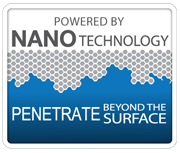
“NANO” has its roots in the greek “nanos”, meaning dwarf. It is the one thousand millionth part of one metre (0,000 000 001m). The relationship between a nanometre to a metre is the comparison of a hazelnut to the planet earth. Though the word “nano“ has become somewhat of a buzzword in respect of advertising, it is in fact a synonym for the portal to a completely new world in which the dimensions of molecules and atoms play their parts.
Nanotechnology is considered to be the key technology for the 21st century.
Chemical nanotechnology concerns itself with the investigation, manufacture and uses of structures which are below 100 nanometres. The aim is to identify new characteristics of objects measured on the nano scale, to understand these (and their causes) and to transfer this knowledge into technical developments and (new) applications.
How nano particles react with each other
In the context of surface coatings, compare the size and behaviour of ordinary particles in traditional coatings to those that are Nano-sized. A nano particle is much smaller and collectively, the mass of nano particles has many more sides to adhere to the substrate. If you consider a cube has 6 faces, if that cube was halved it would have twice as many faces. Consider the Nano as the original cube being sectioned 1000 times. How many faces is that?
How nanoparticles make surfaces smoother
Here we see a traditional coating where the particles are actually too large to adhere to the majority of the substrate. Compare this with the nano coating which not only adheres better to the substrate but also to its own components. Because of this you can apply the nano coating more successfully and thinner than the non-nano coatings. One can also see that the finished result is a much tighter, thinner, stronger and smoother coating.
Coatings, as an example:
It is expected of coatings that they protect the material upon which they are applied against the effects of external forces and that they bond well with the material to which they are applied. In addition, dust and dirt and other foreign material should not stick to the surface. They should be easy to clean, resistant to chemicals and abrasion. They should have an excellent gloss finish and long-life properties.


